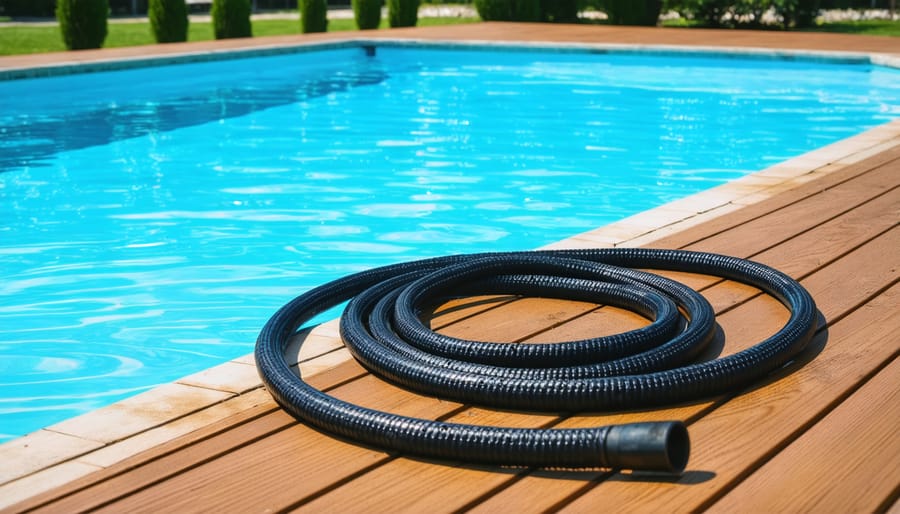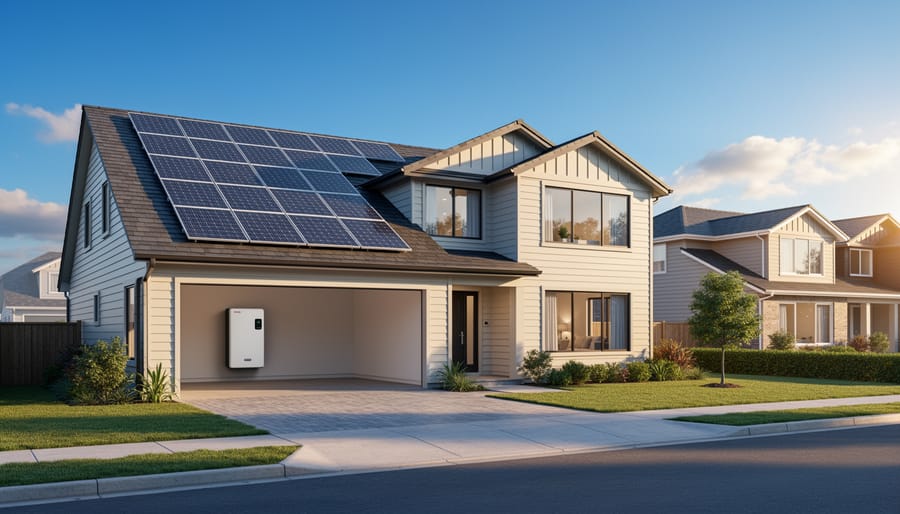Pool Solar Panel Installation: Pro Installation or DIY?
Updated:

A DIY pool solar panel installation can save you almost half the cost of a pro installation, and before you doubt yourself, you CAN do it.
Let’s get started with the basics.
What Are Solar Panel Pool Heaters?
A solar panel pool heater relies on pool water circulated through a series of tubes or pipes exposed to sunlight. That’s a simplistic way of putting things, but it’s the entire theory.
Most folks have felt how hot the water in a garden hose that has been in the sun for a while. So, the core concept is remarkably effective, and if you decide to install solar panels to heat your pool, the heating is free.
What Kinds of Solar Panel Pool Heaters Are There?
Four types of commercial solar panel pool heaters are used in most installations.
- Flexible mat heaters
- Unglazed solar panel heaters
- Glazed solar panel heaters
- High-temperature solar collectors
Let’s check each one out briefly to see how they work, what pool types and environments they are suited for, and approximately how much they cost.
Flexible Mat Heaters
These are the least expensive solar heaters and among the easiest to work with and install. The pool solar panels consist of a serpentine tube coil sandwiched between two fabrics or flexible UV-stabilized PVC sheets. Each sheet has an inlet and outlet and may be used singularly or in groups of solar panels for a larger surface area and higher output. Here is an example.
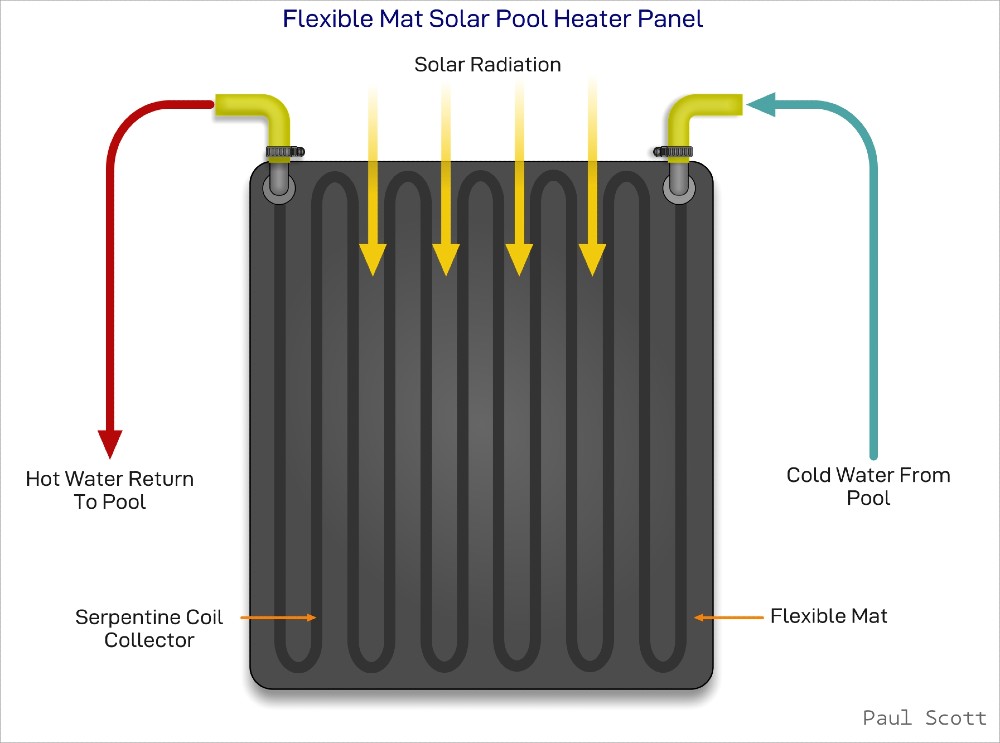
For the most part, flexible mat heaters use a mobile, submersible pump, and the mats can be connected using ordinary garden hoses and fittings. These pool solar panels are ideally suited for small to mid-sized pools in warm climates. To install a solar pool heater using flexible mat collectors would cost approximately $500 and $3,000, depending on the pool size.
Unglazed Solar Pool Panel Heaters
Unglazed pool solar panels are generally larger than flexible mats and are primarily designed for permanent installation. They consist of manifolds and vertical riser tubes, as illustrated in the basic example below.
Depending on the design, the pool solar panels can be exposed or encapsulated in a UV-stabilized rubber sheath.
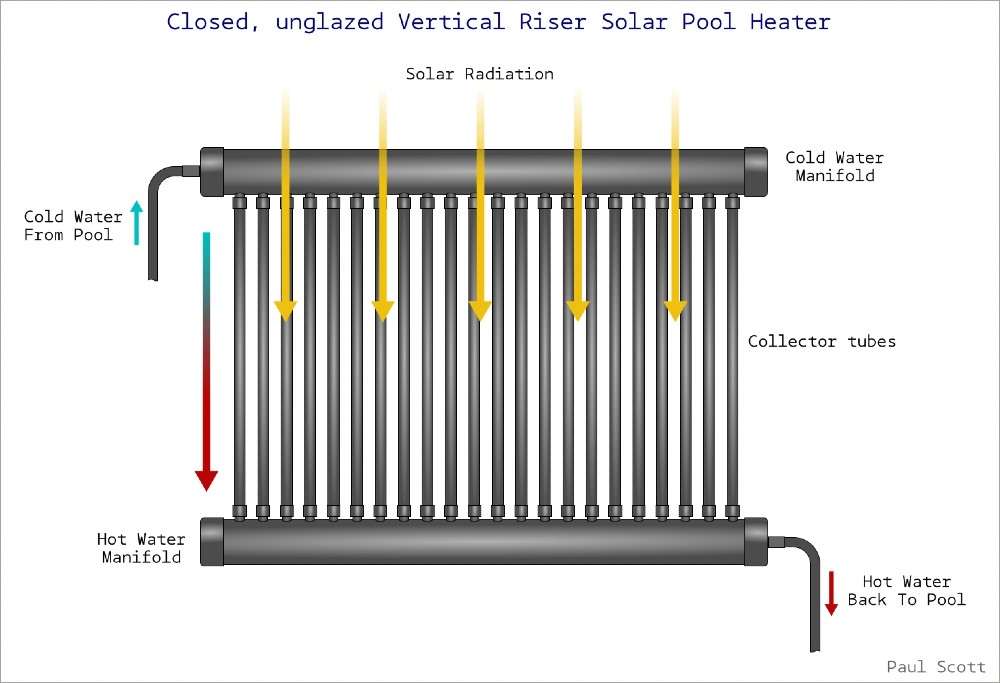
Non-glazed solar pool heater panels may be ground or roof-mounted and are typically grouped in relatively large permanent installations. These pool solar panels may use a dedicated pool pump or be plumbed into the existing filter pump circuit.
Except for the most significant pools, these heaters may be used for most pool types and sizes. They are well suited for hot climates but less effective than glazed pool solar panels in cooler weather. An unglazed solar pool heater panel will cost between $1,500 and $4,000 to install.
Glazed Solar Pool Panel Heaters
Glazed solar pool heating systems are similar to unglazed systems in their general layout and operation. The most crucial difference is that they’re packaged in sealed, insulated boxes with clear polycarbonate or tempered glass covers.
This arrangement dramatically reduces heat losses and makes these solar panels much more efficient. The basic glazed pool solar panels concept is illustrated below.
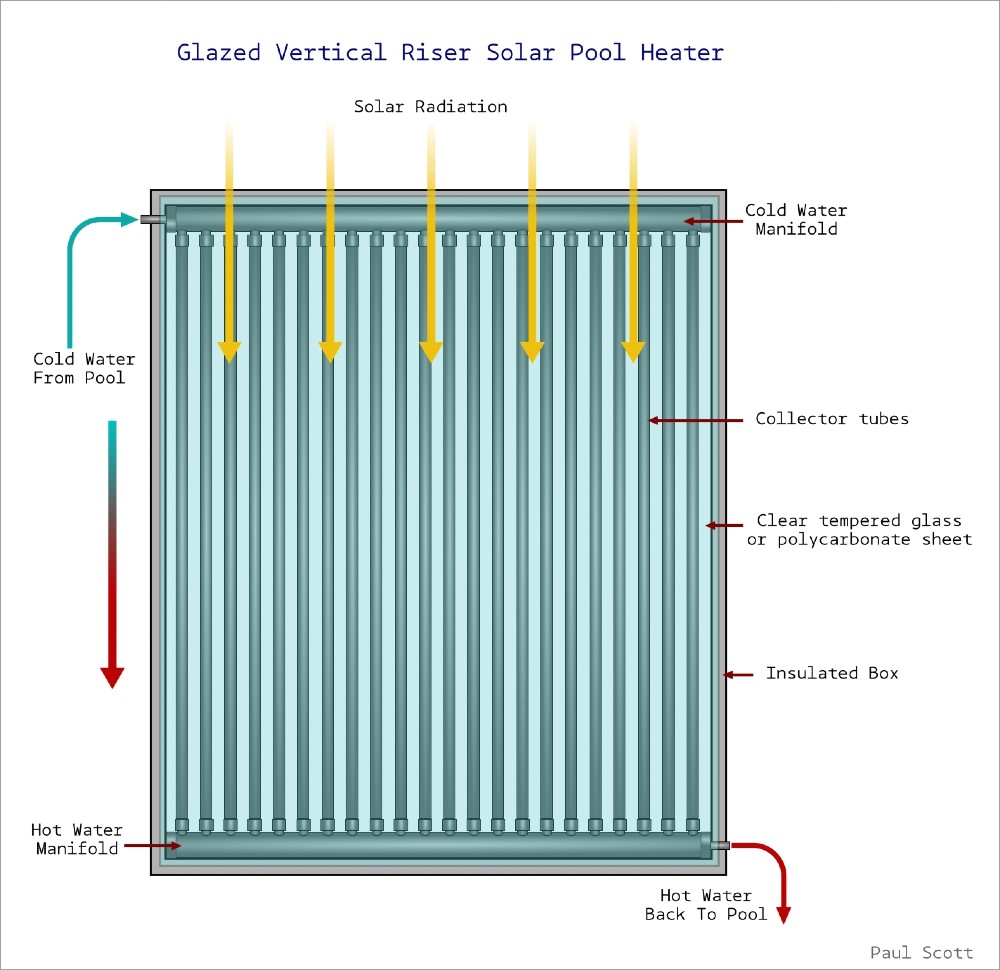
The substantial increase in the efficiency of glazed panel solar pool heating systems makes them ideal for colder climates and locations without direct sunlight. The increased efficiency does mean these solar panels are more expensive than unglazed types, though.
They are also suitable for all but the largest pools and will cost approximately $3,000 to $8,500 to install.
High-Temperature Vacuum Tube Solar Panel Pool Heaters
These are the big boys in the solar pool heating game. These solar panels can generate efficiency levels; others simply cannot and even work well in overcast or cloudy weather.
There are two types of vacuum tube heaters: closed and open tube types. Although they operate differently, they are set up in the same way and are visually similar. Here is an example of a vacuum tube solar pool heater.
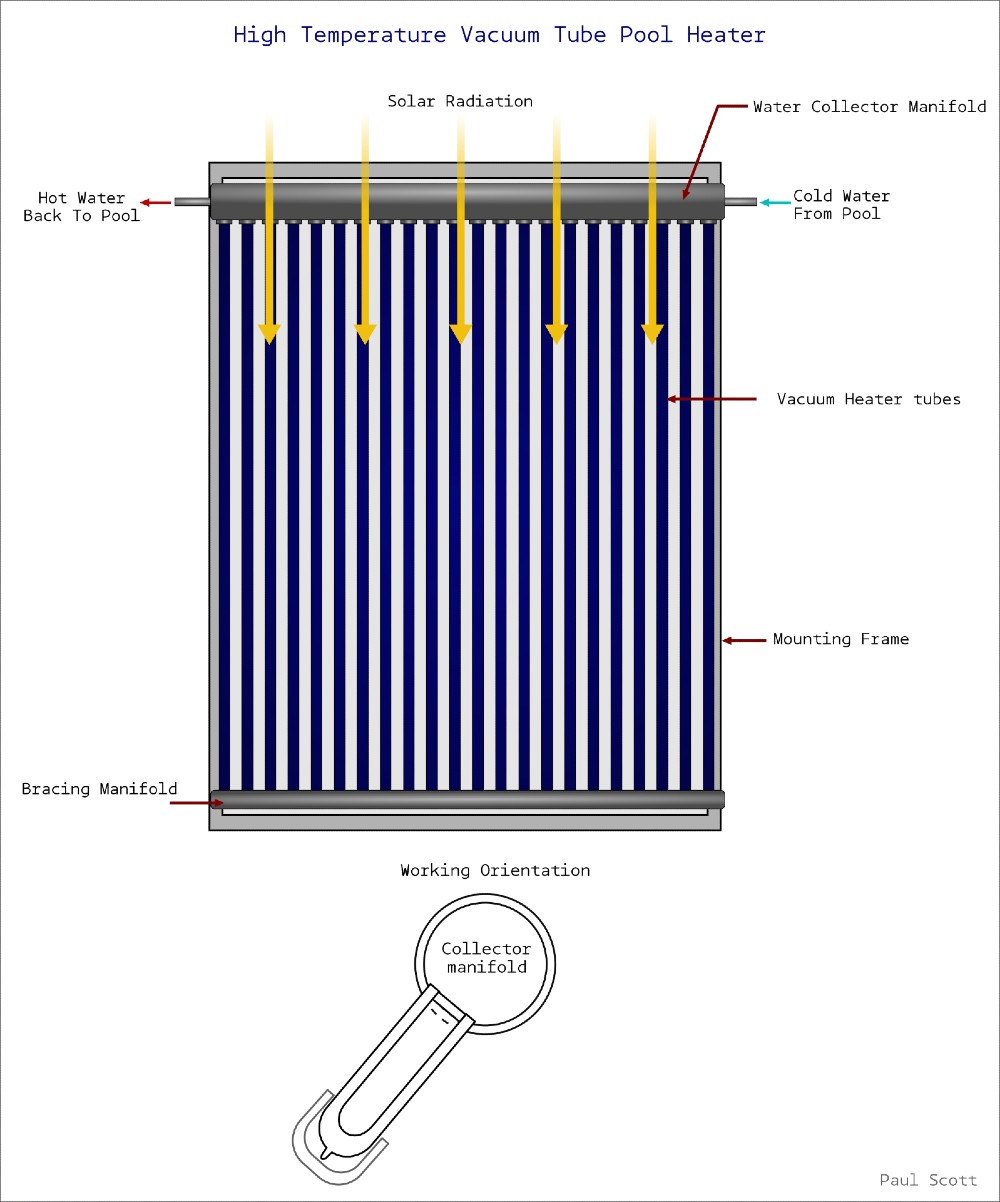
These solar panels use thermo-siphoning or heat tube elements in a vacuum to heat the pool water. Their design specifics make them very effective, and they can heat even the largest pools. Installing solar panels of this type will cost between $ 9,000 and $ 11,000.
Sizing and Working Out Specs for a Pool Solar Panel Installation
Here’s an essential guide to calculating the number of solar panels you’ll need to heat your pool efficiently. In addition, we’ll consider the differences between the above and in-ground pool types.
Pool Size vs. Required Number of Solar Panels
Using the Pool’s Surface Area
When choosing a solar pool heating system, you will need to work out the surface area of your pool.
A safe rule of thumb in mild climates is that you’ll need a solar panel area equal to the pool’s surface area. Half the pool’s surface area would be a fair average in warm or hot areas.
Using BTU Ratings
Calculating the number of panels required to heat your pool is more complex but precise. The BTU (British thermal unit) calculation uses a formula based on the following facts.
- The sun generates around 300 BTU per square foot per hour.
- On the low end of the scale, solar panels are 50% efficient and, at most, 75% efficient.
- It takes 10 BTUs every hour per square foot of the pool area to raise one degree.
BTU Calculation
Now, all solar heating system panels carry a BTU rating that allows you to use this method of calculating solar heating system requirements. So, using an 18 x 36-foot pool as an example and a target temperature gain of 7 degrees, let’s implement this method.
- The pool’s surface area is 648 ft² (18 x 36 = 648).
- You would multiply the 648 feet by the 7-degree target gain to get the total temperature gain factor, giving you a working gain factor of 4 536.
- Now multiply the gain factor by the ten BTU per square foot per hour. That gives you 45 360 BTUs per hour.
- To calculate a panel area based on the sun’s 300 BTU/Hr potential, you’d divide 45 360 by 300 for a result of 151.2.
- That line of the equation assumes a 100% panel efficiency rating, which is impractical. To reach a final solar pool panel area figure, use the lower end of the efficiency scale, i.e., 50%. So, you must double the 151.2 figure to get a realistic result. The result is a panel surface area of 302.4 ft².
Pool solar panels come in various sizes, but the most commonly used are 4′ x 10′ and 4′ x 20′. So a 4′ x 10′ panel has a surface area of 40 ft², and a 4′ x 20′ panel is 80 ft². Using the BTU calculation, we now know we would need 303 ft² of the solar pool heater panel area. If you chose to use 4′ x 10′ (40 ft²) panels, you’d need 8 panels (303/40 = 7.58).
This may be a reasonably complex method, but it is more science than thumb-sucking, so it’s worth considering.
Calculating Your Pool Surface Area
Calculating the surface area is easy if you have a round, square, or rectangular pool.
- Round pools: The formula for calculating the surface area is 3.14 (π) x pool radius². In other words, if your pool is 18 feet wide across its center, the radius is 9 feet, which is how to work out the surface area. 3.14 x (9 x 9) or 3.14 x 81 = 254.3 square feet.
- Square or rectangular pools: These are easy – you multiply the length and breadth of the pool. For example, if your pool is 36 feet long and 18 feet wide, the calculation would be 36 x 18 = 648 square feet.
Several good resources have online pool area and volume calculators to calculate surface areas of complex pool shapes.
If your goal is to raise the temperature of your pool from 5 to 7 degrees during the “swimming” season, the takeaway from all this equates to the following:
- When you’re in Florida and have a 254-square-foot surface area pool, you’ll probably get away with 130 to 140 square feet of pool solar panels.
- If you live in Montana with the same pool, a safe figure is 300 to 350 square feet of solar heater panels.
Above Ground vs. Inground Pools
Several pool heating considerations revolve around pool installation types.
For example, above-ground pools tend to heat quickly but lose the accumulated heat faster than conventional in-ground pools. This is due to the insulating soil mass around an in-ground pool and the heat transfer potential of the air around an above-ground swimming pool.
The debate low down is this. You’ll need fewer pool solar panels to maintain your target temperature if you have an in-ground pool. An in-ground pool may take a little longer to reach that thermal sweet spot, but it will hold the heat longer than an above-ground pool.
Solar Pool Heating: Professional vs. DIY Installation
There are a fair number of pros and cons relating to both methods of installing a solar pool heater. Your ability to maximize the pros and minimize (or eliminate) the cons will depend largely on canny decision-making and being well-informed.
Professional Installation of a Solar Pool Heating System
Having your pool solar panels installed professionally is undoubtedly the easiest way. For those who aren’t inclined to get technical or are pressed for personal time, a pro install is a way to go.
Let’s look at some pros and cons of installing solar panel pool heaters.
Pros
- The benefit of experience. Reputable installers have masses of experience of the game that even the most seasoned DIY handyperson will never have. They can make valuable recommendations, sound calls on installation specifics, and sidestep the pitfalls that litter this project.
- Workmanship warranties. Again, reputable installers will not only honor parts and equipment warranties but also guarantee their own workmanship. More on this later.
- Speedy installation. A professional installer will get the job done much quicker than you will.
Cons
- High cost. Labor is expensive, and no right-minded person works for free. However, the added labor cost is not the end of the financial stinger. Everything will cost you more as installers usually mark their equipment and consumables, even though they may buy them wholesale.
- Tricks of the trade. Sadly, not all installers are honest, and the trade is awash with scams, dodgy dealings, and outright theft in some cases. In the next section, we’ll look at ways to protect yourself against getting taken for a ride.
Tips for a Professional Solar Pool Heating System Installation
For the most part, solar heating installers are above board and give good service before, during, and after the installation.
Unfortunately, there will always be the less-than-stellar types out there, ready and willing to fleece the uninitiated. This is the biggest risk pool owners face when using an installer to heat their pool.
Here are some ways unscrupulous operators dupe unsuspecting clients and how to beat them at their own game.
Overspecifying the Installation
This common ruse involves selling you systems far larger and more complex than you need. And here, knowledge is your best weapon.
You’re golden if you know how big your pool is, which type of heater would work well, and how many panels you’ll need. If you can quote those figures off-pat, the installer will know you’re not likely to buy snake oil, no matter what the flavor.
Quoting Hourly Installation Rates
Another common ploy is to quote hourly installation rates and then drag the job out excessively. Demand a fixed installation price and research its validity for your area. If they refuse – show them the door.
Inflating the Scope of Work after the Fact
Once the installer is halfway done with your $1,000 project and suddenly claims he needs to add another grand for some unforeseen omission, you will not have an easy out.
Any installer worth their salt will have an installation contract with a comprehensive scope of work (SOW) clause. Here is a good SOW guide.
Creative Material Quotes
This is a tricky one. It’s easy to load half a roll of tubing, a couple of boxes of fasteners, and a gallon of PVC adhesive into a truck after the work is finished if the client isn’t vigilant.
Ensure you study the materials part of the quote, and don’t be scared to ask what will happen when the job is done with the material left over.
Overstated or Misleading Warranties
This one’s not necessarily an attempt to steal from you but can cost you big. Good installers will ALWAYS give you a comprehensive warranty on their work.
Dodgy operator’s warranties often overstate the parts and materials covered and omit any workmanship liability. A solid warranty will clearly state to which extent the installer’s WORK is guaranteed, not just the materials used.
Going the DIY Solar Pool Heater Route
Installing commercial solar pool heaters yourself can be a rewarding experience if you have the technical ability and equipment needed. Here are some pros and cons of installing a solar heating system yourself.
Pros
- Cost-saving. A DIY solar pool heating system can cost less than half of a pro installation.
- Flexible installation schedule. You can install the solar heating system in stages on a tight budget.
- Flexible solar system structure. Many pro installers only use a set range of products. You can mix and match components at will if you know their compatibility.
- System integrity. You’ll probably do as good or even better a job than a professional installer if you are technically strong. After all, it’s your home and pool, and you’re unlikely to do a bad job of it.
- Intimate system knowledge. If you have installed the system, troubleshooting problems is easy, and you’ll be less likely to have someone in to fix them.
Cons
- No workmanship warranty. If you go the DIY route, any installation problems will be for your account. You’ll benefit from the same materials and equipment warranties a pro installer will give you. So, if you do a good job, this is not going to be a big issue.
- The lack of experience learning curve. Even if you are an excellent, well-informed handyman, there’s no substitute for years of experience. Pro installers have probably seen it over the years and can avoid unforeseen or unknown pitfalls that could foul up a DIY installation.
- Risk of personal injury or property damage. A fall through your roof during the installation will not only put you in the ICU. The repairs to your home would certainly trash any savings on a DIY install. The same applies to accidentally dropping a $ 1,800 vacuum tube panel off the roof.
Tips and Cost Comparisons for a DIY Solar Pool Heating System Installation
The adage “knowledge is power” has been discussed several times in this article. And it’s particularly true if you choose to go solo with your solar pool heating system installation.
A wealth of information is available in almost all installation scenarios to guide you through the process. The more you know and understand the specifics, the smoother the installation.
Here is a good basic game plan for getting ready for the project.
Know Your Pool Specs.
Use the resources mentioned earlier here to get as accurate an idea as possible of your pool’s surface area and volume.
Know Your Site Specs.
Consult online forums and solar resources for information regarding your specific installation location. These specifics will center around your location and your home’s roof pitch and orientation if you opt for roof-mounted solar panels.
Different locations require different panel angles and orientations to ensure optimal performance so that these points will form the core of your installation plan.
Know Your Heater Specs.
Based on the information gathered in the previous two points, you can now decide which type of heater best suits your needs and how many solar panels it will take.
Choose a Pump Setup.
You may install a dedicated pump for your solar heater or tap into your pool filtration circuit. This choice will profoundly affect how the project evolves and its cost and complexity.
Choose a Manual or Automated System.
A manual system is simple and cheaper to install but requires significant vigilance and user input.
An automated system senses the temperature of the air and solar panels and regulates when the system pumps water to the heater. This is very convenient and can make the system as a whole a lot more efficient. Obviously, it adds to the cost of the installation, though.
Assemble a Plumbing List.
Now you know where and how your heater will be mounted. You also know which heater system you will use and how many solar panels it will include. You know which pumping arrangement you’ll use and whether or not the system will be automated.
Based on these known parameters to tie the elements together, you can assemble a list of tubing, valves, fittings, and consumables to tie the elements together. The best way to get this right is to work from a scale sketch of the system.
Assemble an Equipment and Tools List.
The same principle applies to the tools and equipment you’ll need. It’s fair to assume you are a capable handyperson if you are attempting this.
So running through the install plan would give you a clear idea of what you need to get it done properly and, most importantly, SAFELY.
Installing Your Solar Pool Heating System
This part of the project is almost impossible to cover comprehensively due to the many possible system choices. Running a step-by-step installation guide for a glazed panel solar pool heater installation will do you no good if you’ve chosen to use flexible mats.
Fortunately, many pool-related resources advise installing the most popular pool solar heater types. These typically include detailed installation diagrams illustrating all circuit components, including the required parts and equipment. A clear and concise installation diagram will go a long way to flattening the learning curve we mentioned earlier.
For example, here is a basic schematic for a pool solar heater with an automated diverter valve. This layout ties into the existing pool pump and filter circuit. The solar heater controller constantly monitors air and pool water temperatures. When the air is hotter than the pool water—the controller pings the diverter valve to send the pump feed through the heater.
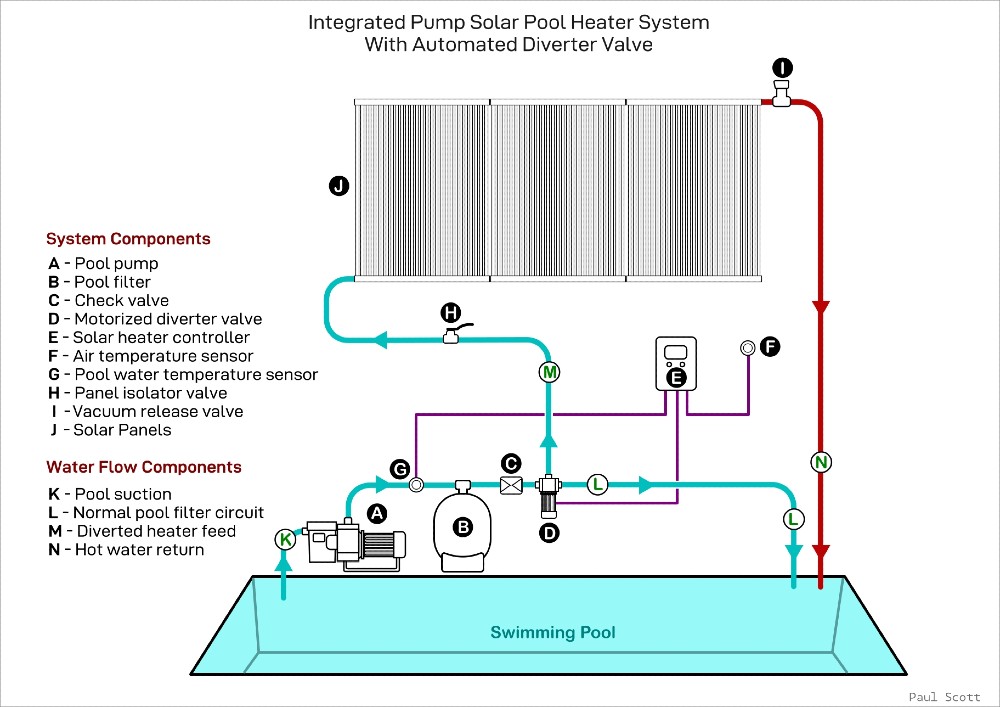
Cost-Saving Implications of DIY Solar Panel Pool Heaters
As each installation is unique and there are so many different types of heaters available, cost-saving figures can only be calculated accurately on a case-by-case basis.
That said, the 2021 average labor costs for professionally installed solar pool heaters are between $500 and $ 3,500. Considering the installed prices mentioned earlier, one could expect to save between 30 and 40 percent on a DIY installation.
In other words, a glazed panel heater for a mid-sized pool that would have cost around $5,800 would cost approximately $4,000. That’s a healthy saving if you can do the installation properly.
How to Maximize the Benefits of Your Pool Solar Heater
The trick is keeping your pool water warm is containing heat loss during cool, rainy weather and at night. A couple of measures you can put in place will help your pool solar heater keep your pool water cozy.
Pool Covers
The humble pool cover is one of the best ways to maintain pool temperatures.
Many great pool covers are on the market, and installing and using them is relatively straightforward. Sizes, designs, and colors are available to suit all swimming pool types.
Auxiliary Active Heaters
If you live in a colder climate or have significant shading issues, installing an electric or propane heater as a backup can be a good idea.
The idea is to use the auxiliary heater to help the pool solar heater under adverse conditions.
Solar Pool Boosters, Sun Rings, or Floating Solar Mats
A solar pool booster, or rather a couple of them, doesn’t heat your pool a whole lot, but they will contribute to the heating process, and every little bit helps.
The Wrap-Up
By now, it should be evident that choosing to have a pool solar panel installation is a good idea. And having it professionally installed or taking it on as a DIY project will largely be a matter of personal choice. There are no solid right or wrong answers.
That choice will be based on your technical abilities, the amount of time you dedicate to the installation, and your budget. Significant pros and cons are attached to each choice, and the right choice is the one you’re most comfortable with. Good luck!
If you have any additional advice, insights, or questions, please drop us a line in the comments section below.




